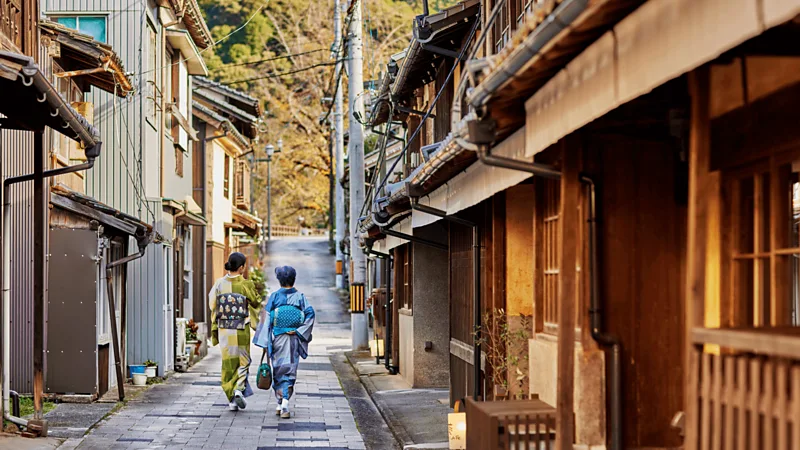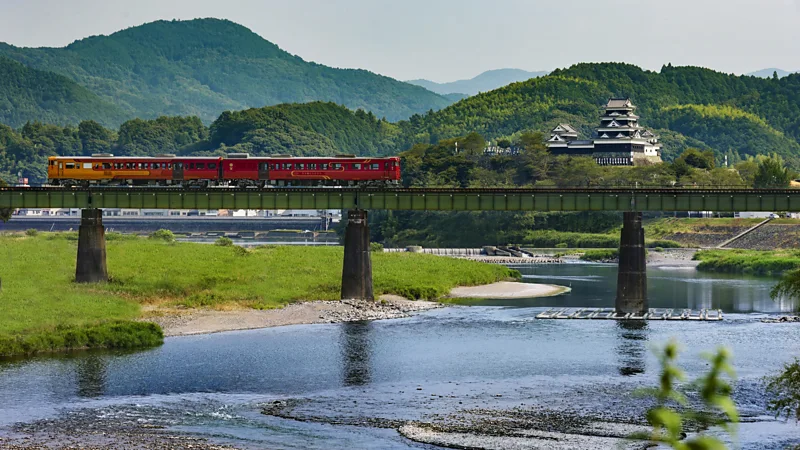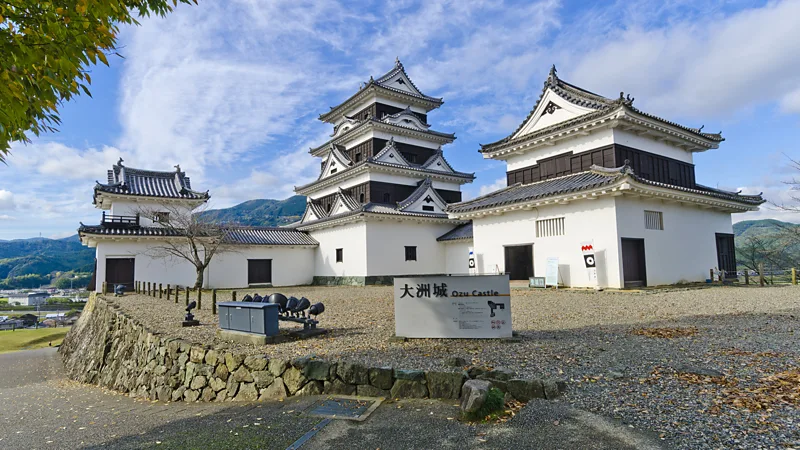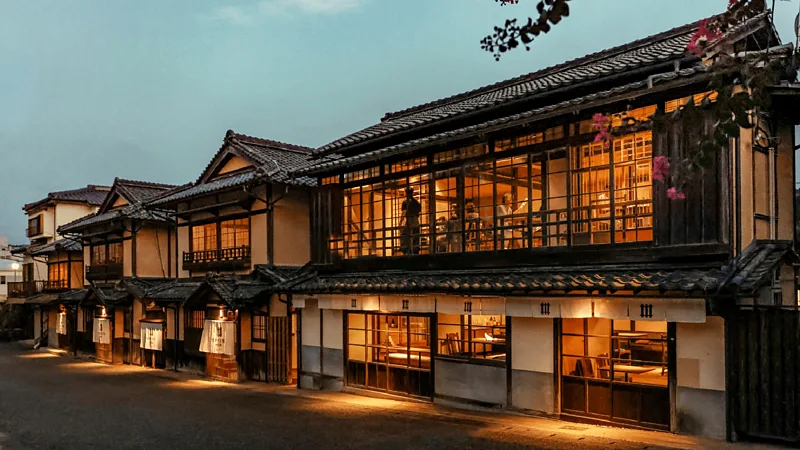The Japanese town where you can sleep in a castle
 Upon arriving in Ozu, visitors have the opportunity to experience a unique form of accommodation spread across historic sites such as an ancient castle, samurai residences, and old merchant homes, all while contributing to the town's renowned model of sustainable tourism.
Upon arriving in Ozu, visitors have the opportunity to experience a unique form of accommodation spread across historic sites such as an ancient castle, samurai residences, and old merchant homes, all while contributing to the town's renowned model of sustainable tourism.
My journey to Ozu led me through a narrow pass nestled amidst the mountains of western Shikoku, Japan's smallest main island. As I descended into the basin formed by the graceful curve of the Hiji River, the striking silhouette of Ozu Castle greeted me. This four-tiered fortress, clad in timber and dating back to the 14th century, commanded attention from its perch atop a central hill. Below, nestled along the riverbank, lay the ancient town, exuding an aura of timelessness and tranquility.
The scene was further enhanced by a delicate mist rising from the river, which mingled with the snow-kissed peaks of the surrounding mountains.
My previous visit to Ozu in 2018 had left a different impression. At that time, many of the town's historic buildings were in a state of neglect, some even abandoned or demolished. The streets were quiet, and after a brief exploration, I continued on my journey without fully immersing myself in the town's charms.
During my visit in February 2024, I was astounded by the remarkable metamorphosis of Ozu. The once quiet old town now teemed with vitality, with the plaza in front of Ozu Machi-no-Eki Asamoya bustling like a vibrant village square. Here, local families mingled with visitors, creating a lively atmosphere. As I made my way to my hotel, I passed by elegant samurai residences adorned with expansive gardens, a testament to Ozu's rich history.
One of the residences housed Shun, a restaurant renowned for serving Ozu's specialty dish, imotaki—a traditional stew featuring chicken, taro, and various vegetables. The restaurant attracted a lengthy queue of patrons eager to savor its culinary delights. Across the street, in a traditional castle town layout, stood merchants' establishments. These buildings, adorned with freshly plastered and white-washed facades, now hosted cafes, bars, and a local history museum.
Often likened to "little Kyoto" due to its historical charm, Ozu served as the capital of the old Iyo feudal domain from 1617 to 1868. During this time, its merchants flourished through the production and trade of wax, silk, paper, and timber. However, Ozu experienced economic decline over the past century, a fate shared by many river towns worldwide, resulting in the deterioration of heritage sites and the migration of residents to larger cities.
In 2019, Ozu embarked on an ambitious endeavor focused on sustainable tourism to preserve its medieval townscape and boost the local economy. This initiative involved conserving and repurposing heritage structures into attractive accommodations and businesses, with the aim of reestablishing Ozu as the cultural heart of the region and attracting both tourists and residents. The efforts yielded remarkable success, culminating in Ozu being recognized as one of the Top 100 Sustainable Tourism Destinations by Green Destinations in 2023.
Furthermore, it secured first place in the Culture and Tradition category of Green Destinations' Story Awards, highlighting its success in revitalizing the town by leveraging its cultural assets. Ozu now stands at the forefront of Japan's ambitions to become a leading sustainable travel destination worldwide.
During my stay, I lodged at Nipponia Ozu Castle Town Hotel, which serves as the focal point of the town's revitalization efforts. This innovative "scattered hotel" is the result of a collaborative effort between the Ozu City government and community stakeholders. Instead of a centralized location, the hotel's central services and rooms are dispersed across various buildings and locations within the town.
Upon its opening in 2020, Nipponia Ozu Castle Town Hotel offered visitors the unique opportunity to spend the night in a castle, a first in Japan. Additionally, guests can choose from 31 rooms spread across 26 meticulously restored buildings scattered throughout the city. By immersing guests in the local community, the hotel provides them with an authentic experience while preserving Ozu's historic townscape and way of life.
Yuki Inao, the hotel manager, described Ozu's transformation as nothing short of miraculous, considering how rapidly, comprehensively, and successfully it occurred. He noted that in 2023, when Japan lifted its travel restrictions post-pandemic, Ozu Castle was nearly fully booked.
A stay at Ozu Castle is a grand and immersive experience. It commences after 5:00 PM when the castle museum closes. Guests, adorned in kimono or samurai armor, make their entrance to the castle on horseback, accompanied by a retinue of local actors portraying samurai retainers. The evening unfolds with traditional performances, such as gagaku court music or Shinto kagura dance, followed by a lavish dinner served in the Koran Turret.
This turret, where Ozu's former lords, the Kato family, once enjoyed sake while admiring the moon, sets the stage for an unforgettable dining experience. Later, guests retire to sleep in the keep, a distinctive two-story timber-latticed open space within the main castle tower. The following morning, breakfast is served at Garyu Sanso, a charming teahouse situated in the castle's pleasure garden, offering picturesque views of the river.
While a stay at Ozu Castle may not fit everyone's budget, priced at ¥1,320,000 (approximately £7,000) per night for two guests, I found it to be a meaningful gesture from the town, symbolizing its inclusive and hospitable approach to all visitors. My experience staying there was both genuine and luxurious, reflecting the town's commitment to providing an authentic and indulgent experience for guests.
Immersed in Ozu's Historic Atmosphere: A Weekend Stay
 The hotel's accommodations consist mostly of suites housed within entire residences scattered throughout the old town, spanning its approximately 1.5km length. These suites vary from the former residence of the Kato family post-feudalism to homes boasting secluded courtyard gardens and private teahouses, as well as townhouses nestled in the lively town center.
The hotel's accommodations consist mostly of suites housed within entire residences scattered throughout the old town, spanning its approximately 1.5km length. These suites vary from the former residence of the Kato family post-feudalism to homes boasting secluded courtyard gardens and private teahouses, as well as townhouses nestled in the lively town center.
During my weekend stay, I occupied a two-story terrace house once inhabited by a wax worker over a century ago. The upper floor featured a bedroom with views of a quaint lane dotted with charming shops, while the lower level housed a modern bathroom with a traditional hinoki wood soaking tub. Adjacent to the spacious garden was the hotel's club lounge, where I enjoyed complimentary drinks from a self-service bar and mingled with fellow guests exploring the city.
Stepping outside my rooms, I was immediately enveloped in Ozu's ambiance. To reach the hotel's reception, I traversed a narrow cobblestone street, passing by an imposing earthen-walled storehouse, now transformed into another suite. I then entered the grand hall of a 400-year-old mansion once owned by a wealthy wax merchant. A short walk from there led me to breakfast, served in one of the hotel's restaurants housed in a former ryotei. For dinner, I dined in a gracious old mansion located at the foot of the castle, just a leisurely 15-minute stroll away.
Promoting Sustainable Tourism: A Collaborative Approach
Diego Cosa Fernandez, the sustainability coordinator at Kita Management, emphasized that Ozu's approach to sustainable tourism aims for a harmonious balance between residents and visitors, ensuring benefits for all parties involved. During my exploration of the town alongside Fernandez and his colleague Ayano Iga, it became evident that this philosophy guides their actions.
The hotel's street-facing shops seamlessly integrate into the town's historic ambiance, complementing a growing array of businesses occupying other restored structures. These businesses are carefully curated, prioritizing local and regional crafts and products such as Tobe ware, Ikekuchi organic cotton towels, and Silmore health and beauty products derived from silk—a nod to Ozu's rich heritage as a silk cocoon producer. Ayano Iga noted that these offerings are highly sought-after by local residents, underscoring their appeal and significance to the community.
During my exploration of Ozu, I encountered Unagi no Nedoko's trendy store, marking its first venture beyond its Fukuoka City origins. Here, visitors can find traditionally crafted monpe farmers pants and hanten jackets, adding a touch of sophistication to Ozu's evolving cultural landscape. The seamless integration of these stylish new businesses reflects the town's revitalized identity as a regional cultural center.
When I spoke with Yuki Inao about Ozu's remarkable transformation, she emphasized the collaborative efforts of the city government, hotel, and community. "We are a family," she remarked, highlighting the close-knit relationship that has been pivotal to Ozu's success.
This inclusive community spirit is not only evident in the town's revitalization but also in its ability to attract new residents. Yosuke Inoue, from Kita's strategic planning department, shared that while he returned to Ozu as the 18th generation of his family to reside there, more than half of the new residents are newcomers to the town. This influx of fresh faces underscores Ozu's growing appeal as a welcoming and vibrant community.
Personal Reflection
 During my time in Ozu, I had the pleasure of meeting several new residents – hotel staff, city employees, and shop owners – each with their own compelling reasons for choosing Ozu as their home. Their sentiments echoed a common theme: an admiration for the town's rich history, its vibrant community spirit, and the tranquil natural surroundings. As someone who enjoys exploring on foot, I found myself drawn to the winding roads that meandered into the surrounding hills, where ancient Buddhist temples and Shinto shrines added depth to Ozu's allure.
During my time in Ozu, I had the pleasure of meeting several new residents – hotel staff, city employees, and shop owners – each with their own compelling reasons for choosing Ozu as their home. Their sentiments echoed a common theme: an admiration for the town's rich history, its vibrant community spirit, and the tranquil natural surroundings. As someone who enjoys exploring on foot, I found myself drawn to the winding roads that meandered into the surrounding hills, where ancient Buddhist temples and Shinto shrines added depth to Ozu's allure.
On my last evening, I dined at Le Un, the hotel's restaurant located at the castle's base, where each course served as a culinary homage to Ozu's harmonious blend of tradition and innovation. One standout dish was the tai meishi, a local delicacy featuring red sea bream delicately paired with rice. Departing from tradition, this rendition showcased a modern twist, with layers of sabayon and foam infused with premium soy sauce – a testament to Ozu's ability to reimagine timeless classics.
As I gazed at the illuminated castle from my vantage point, I couldn't help but reflect on Yosuke Inoue's explanation of the town's slogan, "Shiroshita no Machibito," which symbolizes the anticipation and warmth with which Ozu welcomes visitors. Walking back to my accommodations, I felt a sense of belonging, as if I, too, had become part of Ozu's cherished community.













































